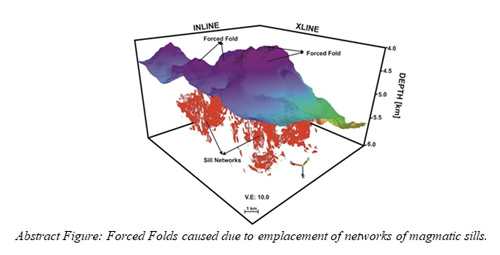 Scientists have found that magmatic intrusions at shallow depths from lower crust or mantle could lead to traps for hydrocarbon and geothermal energy resources.
Scientists have found that magmatic intrusions at shallow depths from lower crust or mantle could lead to traps for hydrocarbon and geothermal energy resources.
A team of researchers from India and New Zealand who studied Taranaki Basin on the West Coast of New Zealand have spotted trapped hydrocarbon and geothermal energy resources due to forced foldings resulting from intrusion of magma in shallow strata.
Magma intrusion into relatively shallow depths often results into the structural deformation of host strata. Forced folds are typically formed above such intrusions in order to accommodate the addition of magma into the sedimentary pile.
Scientists from Wadia Institute of Himalayan Geology, an autonomous institution under the Department of Science & Technology, Govt. of India, in collaboration with Cardiff University, UK and led by the Director WIHG, Dr. Kalachand Sain, have investigated large forced folds that were formed in the geological settings called Upper Cretaceous-Paleocene sequences due to the intrusion of a series of magmatic dikes and sills (intrusions) by using high-resolution 3D seismic volume from the Taranaki basin, offshore New Zealand. They found that forced foldings due to intrusion of magma in shallow strata in the Taranaki Basin on the West Coast of New Zealand have led to the development of four-way closures to form prolific traps for hydrocarbon and geothermal energy resources.
The study published in the journal ‘Geothermics’ hints at the presence of a larger volume of intruded magma than that imaged on seismic data where forced folds are significantly larger than the volume of the sills below. Such a character makes the establishment of fold-sill relationships crucial to the identification of magmatic bodies below forced folds.
Publication Link: https://doi.org/10.1016/j.geothermics.2020.101965






























